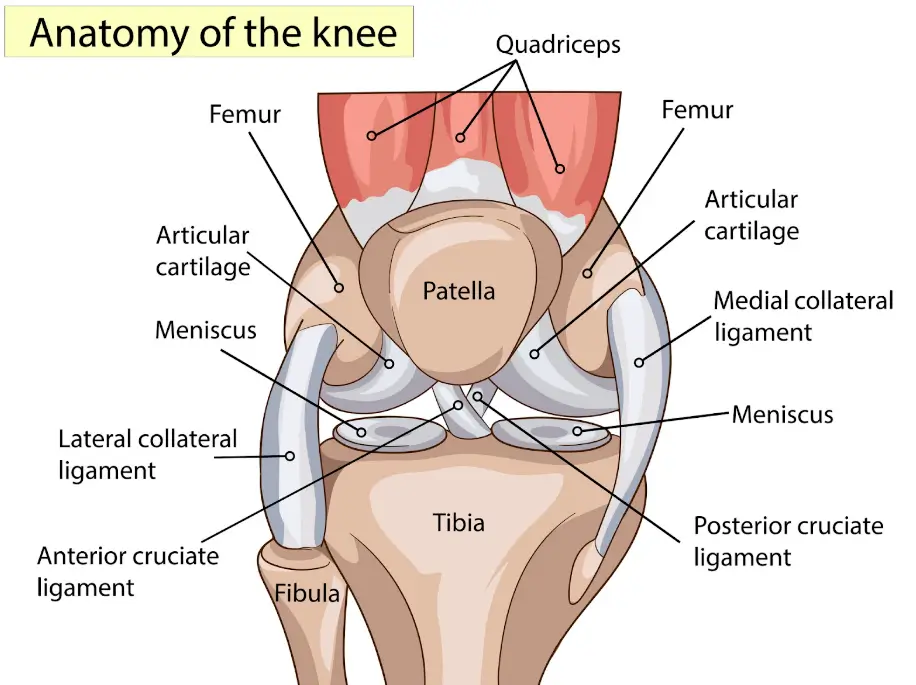Knee Locking Up: Is It A Sign Of A More Serious Problem?

Medically Reviewed By:
Knee locking occurs when the joint suddenly feels stuck and cannot fully bend or straighten. This sensation can be uncomfortable and can interfere with everyday activities, such as standing up from a chair, climbing stairs, or even playing with children.
Often, knee locking is associated with a torn meniscus, which may lead to surgical procedures like meniscectomy to relieve symptoms. Each year, approximately 850,000 of these surgeries are performed in the U.S. However, knee locking can also have other causes that may not always require surgery.
Procedures using Regenexx lab processes utilize interventional orthobiologics to support the body’s natural repair process and may offer an alternative to knee surgery or medication. The Regenexx approach focuses on reducing inflammation, improving joint movement, and addressing the underlying causes of knee locking, with the goal of helping individuals improve mobility and joint function.
Understanding How The Knee Functions
The knee is a complex joint that acts like a hinge, enabling walking, running, and climbing stairs.

Key components include:
- Bones
- Femur (thigh bone): The upper leg bone that forms the top of the knee joint.
- Tibia (shinbone): The lower leg bone that bears most of the body’s weight.
- Patella (kneecap): A small, shield-like bone that protects the knee joint.
- Cartilage
- Articular cartilage: Smooth tissue covering the ends of the bones, allowing friction-free movement.
- Menisci (medial and lateral): Two C-shaped pieces of cartilage that act as shock absorbers between the femur and tibia.
- Ligaments
- Anterior cruciate ligament (ACL): Prevents the shinbone from sliding forward.
- Posterior cruciate ligament (PCL): Prevents the shinbone from sliding backward.
- Medial collateral ligament (MCL): Provides stability to the inner knee.
- Lateral collateral ligament (LCL): Provides stability to the outer knee.
- Tendons
- Quadriceps tendon: Connects the thigh muscles to the patella.
- Patellar tendon: Connects the patella to the tibia.
- Bursae: Sacks of fluid that reduce friction between tissues in the knee.
Despite its strength, the knee is vulnerable to injuries like ligament tears, cartilage damage, and osteoarthritis, leading to pain, stiffness, and reduced mobility.
Recognizing Knee Locking And The Discomfort It Brings
Knee locking occurs when the joint temporarily becomes stuck and can’t fully bend or straighten. The sensation can range from mild discomfort to a complete inability to move the knee, disrupting normal activities. Some common symptoms include:
- Clicking sensation during movement: Clicking or popping sounds may indicate underlying knee conditions. Different types of noises are:
- Loud pops: Often heard at the time of injury. Research from 2023 suggests that 70% of ACL tears are accompanied by a “pop” and sharp pain.
- Crepitus: A softer, repetitive noise caused by friction, often associated with cartilage wear and osteoarthritis. A 2024 study found that knee crepitus was prevalent in 41% of the general population and 81% of osteoarthritis patients.
- Swelling or stiffness around the knee joint: Inflammatory conditions or injuries may lead to fluid buildup, which can cause stiffness and swelling that restrict movement. These conditions may include arthritis, ligament injuries, or meniscus tears.
- Instability or discomfort when bearing weight on the knee: The knee may feel unstable or as if it is about to “give way,” particularly when walking or climbing stairs. This sensation can make weight-bearing activities challenging and may contribute to further strain or injury.
Main Causes Of Knee Locking
Knee locking may result from mechanical obstructions within the joint or inflammation caused by specific conditions or injuries. These issues can affect individuals of all activity levels, from athletes experiencing high-impact injuries to older adults with age-related joint changes.
Common conditions responsible for this symptom include:
Muscle And Ligament-Related Causes
Muscles and ligaments play a crucial role in knee stability and movement. When these structures are injured, they can contribute to knee locking by disrupting joint mechanics or support.
- Dysfunction of the popliteus muscle – The popliteus muscle at the back of the knee connects the femur and tibia. It is key in unlocking the joint during movement and assisting in knee flexion and rotation. This muscle also stabilizes the lateral meniscus by preventing it from being pinched during knee movements.
When this muscle tightens or becomes impaired, it can trap the meniscus between the tibia and femur, leading to knee locking. Over time, this repeated stress may lead to meniscus tears. Treating popliteus dysfunction is essential to restoring proper movement and preventing further damage.
- Ligament damage – Knee ligaments maintain stability by aligning bones and regulating joint movement. Injuries to ligaments like the ACL or MCL can cause instability and reduced joint motion, leading to locking sensations, especially during weight-bearing activities. These injuries may result from trauma, high-impact sports, or wear and tear.
Structural Or Mechanical Issues
Structural or mechanical issues within the knee joint may interfere with movement, sometimes leading to locking sensations. These issues can result from factors such as joint misalignment, repetitive strain, or damage to key structures within the joint.
- Plica syndrome – Plica syndrome may develop when repetitive stress or overuse irritates the plica, a soft tissue fold inside the knee. When inflamed, the plica can thicken and become positioned between moving structures in the knee, which may contribute to pain, swelling, and occasional locking sensations.
- Patella dislocation – A dislocated patella (kneecap) occurs when the patella moves out of its typical position within the patellofemoral groove at the end of the femur. This may result from sudden movements, trauma, or twisting of the knee. Patella dislocation can disrupt joint alignment and restrict motion, which may contribute to locking sensations.
Underlying Conditions
Knee locking is not always caused by physical obstructions. Other conditions, such as chronic pain conditions like osteoarthritis or nerve-related issues, may contribute to muscle spasms that temporarily restrict knee movement.
- Pseudo knee locking: True mechanical knee locking occurs when a structural obstruction prevents movement. In contrast, pseudo-knee locking results from significant knee pain triggering muscle spasms, which interfere with knee motion without an actual obstruction. Pseudo-locking may be associated with knee injuries, inflamed tissues, nerve-related conditions, or patellar maltracking—a condition in which the kneecap moves out of alignment. Differentiating pseudo-locking from true locking is important for determining appropriate treatment. Imaging studies, such as MRIs, may help identify structural causes versus pain-driven movement restrictions.
- Anterior Cruciate Ligament (ACL) Tears: An ACL tear is a partial or complete rupture of the anterior cruciate ligament in the knee, often caused by sudden twists or high-impact movements. It may lead to pain, swelling, instability, difficulty bearing weight, or changing direction. Read More About ACL Tears.
Diagnosis Of Knee Locking
Accurate diagnosis is important for identifying potential causes of knee locking and determining appropriate treatment options. Common diagnostic processes include:
- Physical Examination – Physicians assess knee motion, swelling, and stability to help determine potential underlying factors contributing to knee locking.
- Imaging Tests – These tests provide detailed views of the knee’s internal structures, helping identify possible obstructions, injuries, or structural concerns. Common imaging options include:
- X-rays – Used to visualize bones and assess for fractures or alignment variations.
- MRIs – MRIs provide detailed images of soft tissues, such as the menisci and ligaments, to help detect tears or other abnormalities.
- Medical History and Symptom Review – Physicians review past injuries, symptoms, and activities that may aggravate knee issues to develop a comprehensive understanding of the condition.
Available Treatment Options
Treatment options for knee locking depend on what’s causing this symptom. Common treatments include:
- Rest, Ice, Compression, And Elevation (RICE) Method – This approach involves resting to prevent further strain, applying ice to help manage swelling, using compression to limit fluid buildup, and elevating the knee to support circulation. These measures may help alleviate inflammation and discomfort. However, 2023 research suggests that prolonged icing may reduce blood flow to the injured area, which could affect the healing process.
- Physical Therapy – A physical therapist may guide individuals through exercises to strengthen the muscles around the knee, improve flexibility, and enhance stability. Additional techniques such as massage, joint mobilization, or dry needling may also be used to help relieve tension and support mobility.
- Non-Steroidal Anti-Inflammatory Drugs (NSAIDs) – These medications are commonly used to help reduce inflammation and manage pain. Long-term use may be associated with potential risks, including effects on heart and kidney health.
- Arthroscopy – This surgical procedure involves inserting a small camera and specialized instruments to assess and address damaged tissue inside the knee. Potential risks may include infection, bleeding, or post-surgical stiffness.
- Patellar Realignment Surgery – In cases of patella dislocation or misalignment, this procedure may be recommended to help improve knee alignment and reduce locking sensations. As with any surgical intervention, potential considerations include infection risk, extended recovery time, and the possibility of persistent knee pain or misalignment.
The Regenexx Approach To Supporting Knee Health And Function
Physicians in the licensed Regenexx network offer interventional orthobiologic procedures using Regenexx lab processes. These procedures utilize a patient’s own blood or bone marrow to assist the body’s natural repair processes, which may help reduce inflammation, promote mobility, and support joint function in individuals experiencing knee locking.
Understanding the root cause of knee locking is essential for determining the most appropriate care plan. If you’re experiencing persistent knee locking, consult with a physician in the licensed Regenexx network.

Medically Reviewed By:
